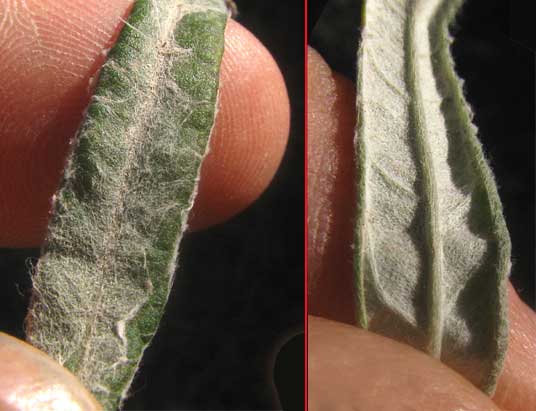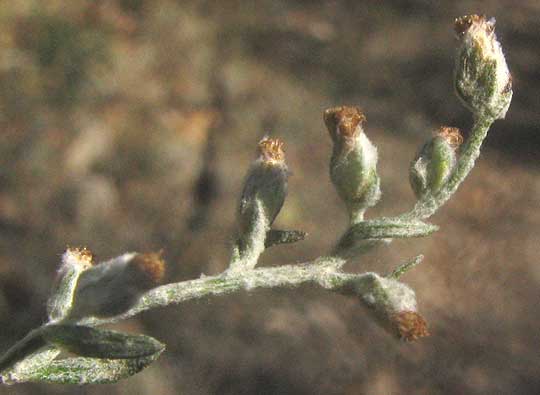Excerpts from Jim Conrad's
Naturalist Newsletter
from the December 15, 2013 Newsletter issued from the Frio Canyon Nature Education Center in the valley of the Dry Frio River in northern Uvalde County, southwestern Texas, on the southern border of the Edwards Plateau; elevation ~1750m (~5750 ft); N29.62°, W99.86°; USA
WHITE SAGE
If you bike northward, up Dry Frio Canyon into Real County, you gradually rise in elevation. After about three miles you come to the sign saying they'll shoot you if you pass beyond the gate. There you don't feel like you've climbed much in elevation but I've found numerous plants in that area that hadn't appeared farther south and lower in elevation, in Uvalde County. Typically those new finds at the shooting gate are species commonly occurring in the Great Plains' prairies to our north, while farther south on the Coastal Plain at Uvalde the vegetation tends to Mesquite- and Acacia-rich
"scrub," or low thorn forest.
This week not far from the shooting gate, at a woods edge, several stems of a whitish, fine-leafed, slender bush leaned onto the gravel road seeking sunlight, as shown below:

The white herbage is what caught my eye. At first it seemed that the whiteness might be caused by road dust or maybe by white fungal mycelium covering the leaves. However, up close it was clear that the plant body bore a thick mantle of matted, white, cottony hairs. Below, you can see the top and bottom surfaces of a leaf:

Among the stems' upper leaves arose hundreds of tiny flowering heads of the type found in the Composite or Sunflower Family, as shown below:

The urn-shaped flowering heads, only about 1/8th inch high (3.5mm), were past their blossoming time, with the corollas shriveling and cypsela-type fruits developing within the involucres. Below you can see how the heads were arrayed on short stems, or peduncles:

Usually when I encounter a member of the Composite Family new to me I look at details of the flowering head such as what kind of pappus arises from atop the fruit, whether scale-like paleae separate the fruits from one another, etc. However, in these tiny heads such details would be very hard to see; moreover, with the plant having such tiny flowering heads, the white wooliness, and its crushed leaves smelling bitter-spicy, and the leaves tasting like something I'd tasted before, already I thought I knew what genus this plant belonged to.
For, I've spent some time in the western US's high deserts where vast areas were covered with sagebrush of this very color, and sagebrush has clusters of tiny heads just like these, and sagebrush smells good, and has a somewhat similar odor and flavor. Sagebrush is Artemisia tridentata. The genus Artemisia is a big one, with about fifty species just in North America, so surely this was one of those 49 other Artemisia species.
Our roadside plant is widely distributed in western and central North America and northern Mexico. Covering such a large area, it's known by many names, including White Sage, Prairie Sage, Silver Wormwood, Western Mugwort, White Sagewort, Gray Sagewort, White Sagebrush, Mountain Sagewort and a host of similar names. It's ARTEMISIA LUDOVICIANA. Six subspecies are recognized for it in the US, so it's not surprising that it's very variable and occupies a broad range of habitats, from loamy soil in mountain meadows, to sandy soil in deserts and rocky slopes.
With its odor, flavor and availability you might guess that traditionally White Sage was used medicinally. In fact indigenous Americans used it for sore throats, stomach ailments, and difficulty in childbirth. Its leaves were also crushed and employed as snuff to treat sinus attacks, nosebleeds, and headaches. Tea made with White Sage was used in Mexican traditional medicine to alleviate intestinal pain. Extracts of the plant have been shown to display antifungal properties. Indigenous Americans also burned it for incense and some used it constructing their roofs and wattled walls. In cooking, it was used to flavor meat.
Because it's a tough plant with pretty herbage, Silver Sage often is grown in gardens. Several cultivars have been developed, such as 'Silver King' and 'Silver Frost.' It does best in well-drained soils in full sun. It's easily propagated by cuttings and seeds.
So, this is an important plant, though somehow until now I hadn't noticed it. But, there's a lot in life like that, just so many interesting and lovely things still to be met with.